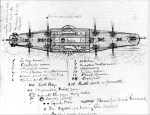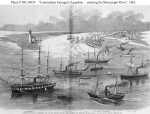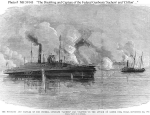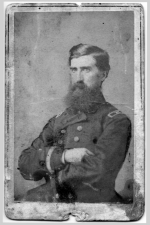Specifications:
Displacement 892 t.
Length 210'
Beam 40'
Depth 13' 6"
Speed unknown
Complement unknown
| Click On Image For Full Size Image |
Size | Image Description | Contributed By |
|
|---|---|---|---|---|
 |
94k | USS Clifton underway off Cape Hatteras in March 1862. From Daniel D. T. Nestell Papers housed at the Nimitz Library, United States Naval Academy, Annapolis, MD. |
Tommy Trampp | |
 |
173k | Deck of the USS Clifton in Fighting Order showing a sketch of her gun emplacements and quarters. From Daniel D. T. Nestell Papers housed at the Nimitz Library, United States Naval Academy, Annapolis, MD. |
Tommy Trampp | |
 |
134k | Line engraving published in "Harper's Weekly", 1862, based on a sketch by an officer of USS Mississippi depicting
Commodore Farragut's Squadron and Captain Porter's Mortar Fleet entering the Mississippi River at the Southwest Pass of the Mississippi, circa 7 April 1862.
Features identified in the engraving's title lines include (from left to right): Light-house on Southwest Pass; USS Colorado (in left foreground); USS Pensacola on the bar; USS Westfield (seen nearly stern-on); Porter's mortar fleet, heading up the river; USS Mississippi on the bar; USS Harriet Lane (side-wheel steamer at the rear of the mortar fleet); USS Connecticut (in right foreground); USS Clifton; town of Banona. US Naval History and Heritage Command Photo # NH 59059 |
Robert Hurst | |
 |
400k | Union mortar steamers bombard Fort Jackson at the Battle of Forts Jackson and St. Philip. From left to right the ships are
USS Clifton,
USS USS Westfield,
USS Owasco, and
USS Signed by J. Davidson. Image from p. 74 of the 1887 book Battles and Leaders of the Civil War, by Robert Underwood Johnson and Clarence Brough Buel, being for the most part contributions by Union and Confederate officers, based upon the Century War Series, volume 2. Courtesy of the British Library from its digital collections. |
Robert Hurst | |
 |
230k | "Fire-raft Sent Down by the Rebels, April 17" A line engraving published in "Harper's Weekly", 1862, depicting USS Clifton playing a fire hose on the Confederate fire raft, as it drifted past Union ships on the lower Mississippi River on 17 April 1862. US Naval History and Heritage Command photo # NH 59065 |
Tommy Trampp | |
 |
155k | "Engagement at Butte la Rose" Line engraving after a sketch by H. Holtz, published in "Harper's Weekly", 1863, depicting the U.S. Navy gunboats USS Estrella, USS Calhoun, USS Arizona and USS Clifton (listed clockwise from lower right) engaging the Confederate gunboat CSS J.A. Cotton off Butte a la Rose, Louisiana, on 20 April 1863. Confederate Fort Burton (shown at left) was captured on the same day. An original engraved print titled,"Engagement at Butte la Rose." published in "Harper's Weekly" dated May 30, 1863. |
Tommy Trampp | |
 |
130k | The Disabling and Capture of the Federal Gunboats 'Sachem' and 'Clifton', in the Attack on Sabine Pass, Texas, September 8th, 1863." Line engraving published in "The Soldier in our Civil War", Volume II. USS Clifton is shown to the left, aground and returning fire from the Confederate fortifications. USS Sachem is at the right.
US Navy photo # NH 59143 from the collections of the US Naval History and Heritage Command |
Tommy Trampp | |
 |
36k | USS Clifton and other Union vessels during the attack on Sabine Pass, Texas, 8 September 1863. Harper's Weekly, dated 10 October 1863. |
Robert Hurst | |
 |
795k | Watercolor by Erik Heyl, 1962, of USS Clifton painted for use in his book "Early American Steamers", Volume IV. She was originally the civilian ferryboat Clifton, built in 1861. After she was captured on 8 September 1863, she became the Confederate gunboat and blockade runner CSS Clifton and was destroyed on 21 March 1864. Watercolor courtesy of Erik Heyl. US Navy photo # NH 63707 from the collections of the US Naval History and Heritage Command |
Tommy Trampp | |
 |
144k | Daniel D. T. Nestell, reportedly born in New York between 1815 and 1819, graduated with honors from the University of the City of New York's University Medical College (later the New York University School of Medicine) in 1843. Following graduation, Nestell, accompanied by one of his professors (Dr. Valentine Mott), traveled abroad for two years in furtherance of his medical studies. Upon his return to the United States, Dr. Nestell reportedly worked as a physician or apothecary until 1862. On January 25, 1862, Dr. Nestell was appointed Acting Assistant Surgeon, to serve on the U.S.S. Clifton (side wheel steamer). While assigned to the West Gulf Blockading Squadron, Clifton participated in the Battle of Forts Jackson and St. Phillip in April 1862, the Siege of Vicksburg in June 1862, and the First Battle of Galveston in October 1862, before being captured by Confederate forces at Sabine Pass, Texas on September 8, 1863. Nestell was subsequently held as a prisoner of war until January 1864, when he was released. After his release from Confederate captivity, and a subsequent furlough, Nestell was assigned to the U.S.S. Alabama (side wheel steamer), again serving as Acting Assistant Surgeon. Assigned to the North Atlantic Blockading Squadron, Alabama took part in the Union attacks on Fort Fisher from December 1864 to January 1865. During the action at Fort Fisher, Nestell suffered irreversible hearing damage. Five months later, on June 6, 1865, Dr. Nestell's appointment as Acting Assistant Surgeon was revoked, and he was honorably discharged from the Navy in August of that year. Image and text courtesy of the Nimitz Library - United States Naval Academy |
Bill Gonyo | |
USS Clifton (I)
Dictionary of American Naval Fighting Ships (DANFS)
| Back To The Navsource Photo Archives Main Page | Back To The Old Navy" Steam and Sail Index |
| Comments, Suggestions, E-mail Webmaster. |
|
This page is created and maintained by Gary P. Priolo |